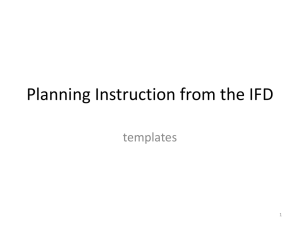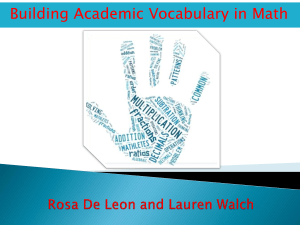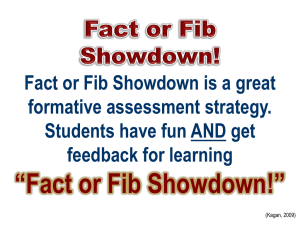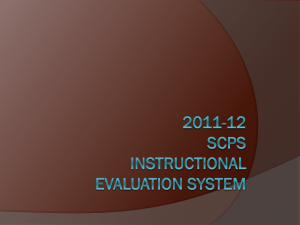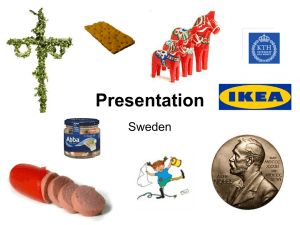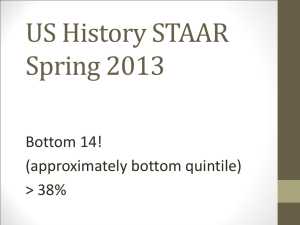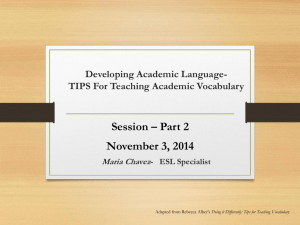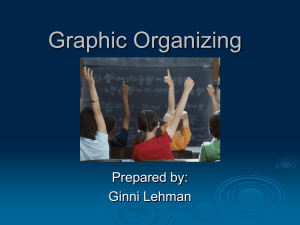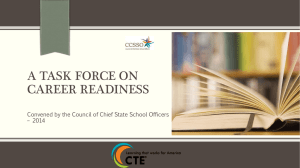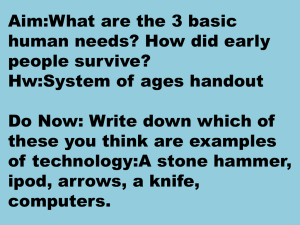Planning Instruction from the IFD: Blank Templates
advertisement
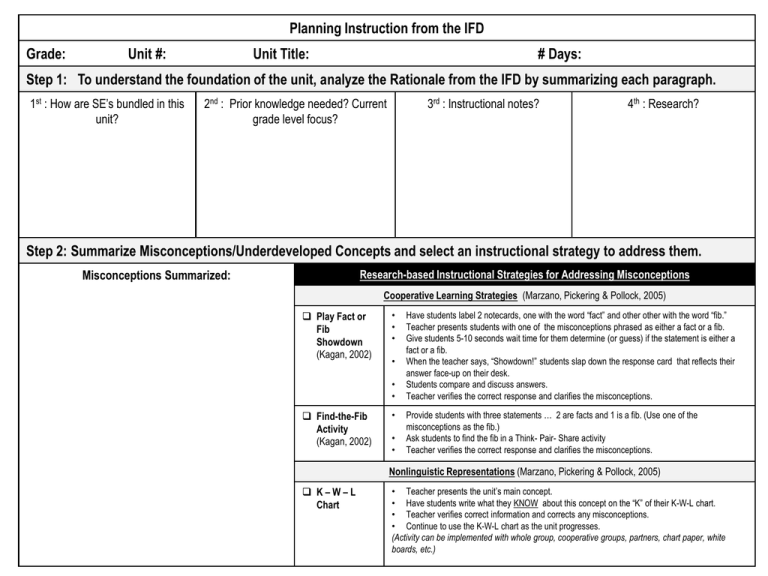
Planning Instruction from the IFD Grade: Unit #: Unit Title: # Days: Step 1: To understand the foundation of the unit, analyze the Rationale from the IFD by summarizing each paragraph. 1st : How are SE’s bundled in this unit? 2nd : Prior knowledge needed? Current grade level focus? 3rd : Instructional notes? 4th : Research? Step 2: Summarize Misconceptions/Underdeveloped Concepts and select an instructional strategy to address them. Research-based Instructional Strategies for Addressing Misconceptions Misconceptions Summarized: Cooperative Learning Strategies (Marzano, Pickering & Pollock, 2005) Play Fact or Fib Showdown (Kagan, 2002) • • • • • • Find-the-Fib Activity (Kagan, 2002) • • • Have students label 2 notecards, one with the word “fact” and other other with the word “fib.” Teacher presents students with one of the misconceptions phrased as either a fact or a fib. Give students 5-10 seconds wait time for them determine (or guess) if the statement is either a fact or a fib. When the teacher says, “Showdown!” students slap down the response card that reflects their answer face-up on their desk. Students compare and discuss answers. Teacher verifies the correct response and clarifies the misconceptions. Provide students with three statements … 2 are facts and 1 is a fib. (Use one of the misconceptions as the fib.) Ask students to find the fib in a Think- Pair- Share activity Teacher verifies the correct response and clarifies the misconceptions. Nonlinguistic Representations (Marzano, Pickering & Pollock, 2005) K–W–L Chart • Teacher presents the unit’s main concept. • Have students write what they KNOW about this concept on the “K” of their K-W-L chart. • Teacher verifies correct information and corrects any misconceptions. • Continue to use the K-W-L chart as the unit progresses. (Activity can be implemented with whole group, cooperative groups, partners, chart paper, white boards, etc.) Step 3: Determine how Performance Indicators and Unit Test (if available) will be implemented and differentiated. • Content: How will you differentiate the assessments in regard to content? • Process: How will you differentiate the assessments in the following areas: flexible grouping, structure, readiness level (strugglers, advanced students, ELL students), and learning styles? • Product: What will you allow students to submit to demonstrate mastery of the Performance Indicators? • Evaluation Method: How will the Performance Indicators and Unit Tests be evaluated? Use the Checklist on the following page to select differentiation strategies for each Performance Indicator and for the Unit Test Summary Performance Indicator #1 Summary Performance Indicator #2 Summary Performance Indicator #3 Content: Content: Content: Process: Process: Process: Product: Product: Product: Evaluation Method: Evaluation Method: Evaluation Method: Unit Test: Available _____ • How are SEs bundled? • Any significant features? Not Available _____ Total # of Questions: ______ # Multiple Choice: ______ # Open-ended or griddable: _____ Content: Process: Product: • Notes on how the questions are phrased. Evaluation Method: Copy this page as many times as necessary to analyze all the Performance Indicators on the IFD. Assessment Differentiation Checklist • • DIFFERENTIATING CONTENT DIFFERENTIATING PROCESS DIFFERENTIATING PRODUCTS DIFFERENTIATING EVALUATION Advanced Readiness Flexible Grouping Processes Nonlinguistic Representations Evaluation Options Blank graphic organizers for advance readiness Added layer of detail • • Individual Partner Activity • Low Readiness • TEKS modifications (based upon IEP) • Word bank • Open-book references • Partially completed graphic organizers for low readiness levels Spanish versions of Performance Indicator and/or Unit Test Cooperative Group Activity Learning Stations Structure Processes • • In-class Homework • • Pre-test Post-test Low Readiness Level Processes • • • ELL • • Word bank Partial outline Sentence frames • • Sentence starters Partially completed Thinking Map or graphic organizer, etc. • • • • • • • • Posters Graphic Organizers Thinking Maps Concrete Models Brochure or pamphlet Illustration Graphs, charts, diagrams Demonstration Advanced Readiness Processes • • Combine Performance Indicators Combine two different strategies (example: nonlinguistic representation + multi-media) Learning Styles Processes • • • Auditory/Verbal: Cooperative Learning structures, presentations, Podcasts Tactile/Kinesthetic: models, card sorts, demonstrations Visual: graphic organizers, color-coding, Thinking Maps, models; uses of highlighters ELL Processes • • • Any of the strategies above Dictionary/glossary use Oral testing • • • Translations Verbal & nonverbal instructions Visual cues • • • • • • • • Maps 3-Dimentional artifacts Display Board Story Board Museum displays Murals Timelines Advertisements • • • • • • • • PowerPoint Presentation Photographs Video Presentation, Interview, Performance Promethean or Smart Board presentation Podcast “Rap” or Musical Performance Written Artifacts • • • • Student journals Manuals, “how to” instructions Compositions Narratives • • • • Biographies Paragraphs Letters Sentences Performance Indicators • • • • • Rubric 4-Point Scale Checklist 100-Point Scale Checked, but not Graded Unit Tests • • • • Original poems, scripts, or stories Editorials 3-2-1 Summary 1-Minute Paper • 4-Point Scale • 100-Point Scale Each question weighted the same Each question weighted according to difficulty level • Checked, but not Graded • Stars & Steps Chart Step 4: To maintain concept-based instruction, make and post a separate Anchor Chart for each of the major CONCEPTS and post a chart listing the KEY UNDERSTANDINGS. Create a chart listing all the KEY UNDERSTANDINGS and post it in the room throughout the unit. Create an Anchor Chart for each of the CONCEPTS. These charts “anchor” student thinking during the unit and follow 5 criteria: 1.) Focuses on a single concept. 2.) Co-constructed WITH the students. 3.) Presented in an organized format [Circle Map, concept map, T-chart, Venn Diagram, list, or any other graphic representation]. 4.) Reflects a developmentally appropriate format. 5.) Allows for additional ideas, examples, and deeper understandings as the unit progresses. Frequently throughout the unit, ask students these questions to continually link lesson activities and objectives with the CONCEPTS and KEY UNDERSTANDINGS: Which KEY UNDERSTANDING fits with the activity we are doing right now? Which CONCEPT is a “big idea” for what we are learning today? What can we add to our Anchor Charts from what we have learned today? Example of Key Understanding Chart: Examples of Anchor Charts: Ideas Added throughout the Unit Step 5: Plan strategies for each step of Marzano’s 6-Step Process for the Key Academic Vocabulary Terms on the IFD. Vocabulary Term Step 1: Teacher Describes Term Step 2: Students Restate Step 3: Students Illustrate Step 4: Students Engage in Activities with the Terms Step 5: Students Talk about the Terms Use the Vocabulary Strategy Checklist on the following page to select strategies for each of the 6-Step process. Copy this page as many times as necessary to include all Academic Vocabulary terms on the IFD. (Marzano & Pickering, 2005) Step 6: Students Play Games 6-Step Vocabulary Strategy Checklist 1. Describe 2. Restate 3. Illustrate 4. Activities 5. Talk 6. Games Provide a description, explanation, or example of the new term. Ask students to restate the description, explanation, or example in their own words Ask students to construct a picture, symbol, or graphic representing the term Engage students periodically in activities that help them add to their knowledge of the terms in their notebooks/journals. Periodically ask students to discuss terms with one another Involve students periodically in games that allow them to play with terms Tell a story Use a video clip Use a current event (something interesting to students) Describe a mental picture of the term Provide a concrete visual or picture of the term Give examples Describe the term in student-friendly language Relate the term to something familiar (video game, song, etc.) Quick skit or role play Concept Attainment Model Possible Restatement Structures: Vocab. Journals Vocab. Notecards kept in a file box 6-step notebook Word Walls (at all grade levels) Anchor Charts To Assist Strugglers (Low Readiness) Teacher provides additional descriptions, examples, or explanations Allow student to partner with another student for a Think – Pair – Share activity Ask student to go on to Step 3 (illustrate) and come back to step 2 if they are struggling Free sketch (preferred method) Word art Collage Magazine pictures Trace a picture Trace a map Frayer Model Compare/contrast terms (Thinking Maps Double Bubble Map or a Venn diagram) Brainstorm synonyms and/or anonyms (Thinking Maps Circle Map) Creating Analogies with the terms (Thinking Maps Bridge Map) Classify/Categorize words (word card sort , a Thinking Maps Tree Map, or a table/matrix) Students may draw … A symbol An example A graphic A dramatization using cartoon bubbles The actual thing Examine cause/effect thinking (Thinking Maps® Multi-flow Map; cause/effect graphic organizer) Describe a term in detail with adjectives (Thinking Maps Bubble Map) Break the word apart visually and/or physically into prefix / root / suffix (Thinking Maps Brace Map; cut word apart physically) Additional graphic or pictures List related words Write brief cautions or reminders List commonly confused words Translate into another language if appropriate Use the terms in Sentence Frames Use the terms in writing assignments or experiment summaries Use a technology application to enhance word meaning (WORDLE Think-Pair-Share Four Corners Give One - Get One Inside-Outside Circle Make-An-Appointment Mix-Freeze-Group Mix- N-Match Quiz-Quiz-Trade Rotating Review Showdown Talking Chips Team-Pair-Solo Who am I? Talk a Mile a Minute Vocabulary Pyramid What’s the Question? (Jeopardy) Charades Pictionary Free PowerPoint Game Templates: http://jcschools.net/tutorials/ PPT-games/ http://people.uncw.e du/ertzbergerj/ppt_g ames.html http://www.wordle.net/; PowerPoint slide, Podcast, Video clip, etc.) (Marzano & Pickering, 2005) Step 6: Analyze Student Expectations to determine the following: identification of Readiness or Supporting standards, a reminder of the cognitive rigor, the content & significant bulleted specificity, supplemental resources, and potential research-based instructional strategies. TEKS SE# R or S Standard? COGNITIVE RIGOR CONTENT SPECIFICITY (The VERBS in both the K & S Statement & the SE) (All Caps) (Include Significant Bulleted Specificity) Supplemental Resources (Page #’s) Potential Research-based Instructional Strategies (Consult Exemplar Lessons if available) Use the Research-based Instructional Strategies Checklist on the following page to select potential research-based strategies. Copy this page as many times as necessary to analyze each Student Expectation on the IFD. Research-based Instructional Strategies (Marzano, Pickering, & Pollock, 2001) Identifying Similarities & Differences* Thinking Maps Compare/Contrast; Classify/Categorize; Analogies Venn Diagrams T-Chart Sentence Frame Card Sort Manipulative Sorts Reinforcing Effort* Thinking Maps Learning Stations Model + Guided Practice [Scaffolding] Anchor Activities Summarizing* Thinking Maps Exit Ticket 1 Minute “Big Idea” paper Delete, Substitute, Keep Strategy Summary Frames Cooperative Rotating Review 3-2-1- Summary Nonlinguistic Representations* Thinking Maps Concept Attainment Inductive Thinking Guess, Test, Revise Strategy Mystery Concept 20 Questions 5 E Lesson Design [Engage, Explore, Explain, Elaborate, Evaluate] Cooperative Learning* Thinking Maps Rubric Stars & Steps Analysis Chart Effort & Achievement Charts Focused Classroom Practice* Generating & Testing a Hypothesis* Thinking Maps Graphic Organizers Kinesthetic Activities (manipulatives, motions, etc.) Role Play Demonstrations Creating model Drawing illustrations Pictographs Jig Saw Think-Pair-Share Mix-Freeze-Group Inner/Outer Circle 4 Corners Take a Stand Fact or Fib Showdown Talking Chips Explore additional Kagan’s Cooperative Learning Structures at www.kaganonline.com Cues, Questioning, & Advanced Organizers* Thinking Maps Bloom’s Question Stems or Question Cubes KWL Charts Partially Completed Graphic Organizers Setting Goals & Objectives* Thinking Maps Smart Goals Stars & Steps Analysis Chart Rubrics, Learning Contract Direct Vocabulary Instruction Thinking Maps Six-Step Process from Building Academic Vocabulary ( Marzano & Pickering, 2005) (*Research-based Strategies from Classroom Instruction That Works by R. Marzano, D. Pickering, & J. Pollock, 2001) Step 7: Revisit the Planning Calendar to determine the number of days truly available for this six weeks. Then consult the VAD and current assessment data to make decisions about compacting or expanding instruction as necessary. Be sure to include the following as NON-instructional days: • District or campus events • Early release days • Staff development days • Community events • Recurring events (pep rallies, picture days, field trips, etc.) After examining the VAD and Exemplar Lessons (if available), what can you do during the unit to make this number of instructional days work? Based upon appropriate benchmark data, pre-tests, Performance Indicator results, and other evidence of student understanding, answer the following questions: • Based on consistent evidence, which Student Expectations have been revealed as thoroughly understood in regard to current grade level content and cognitive rigor? Is this understanding significant enough to allow you to compact instruction in these areas? • Prior to and during the unit, which Student Expectations need the most attention? (Readiness and/or supporting standards? Standards that build to mastery in the next grade level? Standards in which students have had past difficulty?)

